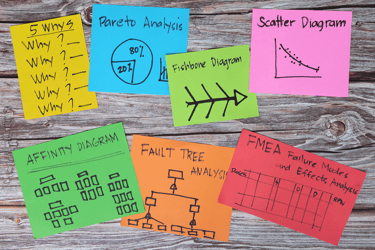The Packaging Industry's Sustainability Challenge: Why ERP Systems Are Essential for Success A straightforward guide to navigating sustainability regulations across folding carton, flexible...
12 Label Printing Industry Trends to Keep an Eye on in 2025
New technologies, market forces, and environmental concerns are impacting businesses across all sectors, and the label printing market is no different.
This blog outlines 12 key trends to help independent and growing label converters prepare for what's ahead.
Contents
- 1. Growth in Digital Label Printing
- 2. Personalization and Customization of Labels
- 3. Increasing Adoption of Cloud-Based ERP
- 4. Automation in Label Production
- 5. Sustainable and Eco-Friendly Labeling
- 6. Smart and Connected Labels
- 7. Advanced Color Management
- 8. Demand for Shorter Runs and Faster Turnaround Times
- 9. Expansion of Hybrid Printing Technology
- 10. Growth in E-Commerce and Direct-to-Consumer (DTC) Labeling
- 11. Digital Proofing and Workflow Automation
- 12. Security and Anti-Counterfeiting Labels
- Conclusion
1. Growth in Digital Label Printing
A market report by Technavio forecasts that the digital label printing solutions market share will increase by $2.32 billion at a CAGR of 6.39% between 2023 and 2028.
This is in part fueled by industries such as the food & beverage sector where custom, small-batch labeling is increasingly important; many label converters are investing in digital presses to meet these evolving customer demands.
The ever-increasing adoption of digital label printing is helping align with growing demands around flexibility, efficiency, high-quality output, cost-effectiveness, short runs, and faster turnaround times.
2. Personalization and Customization of Labels
Personalized and customized labels are becoming a key differentiator for brands looking to stand out on crowded shelves. Thanks to advancements in digital printing, label converters can now offer highly customized label solutions to meet the demand for personalized packaging for specific markets, events, or even individual consumers.
Coupled with the rise of e-commerce and direct-to-consumer models, the trend of companies offering customized products, which extends to their packaging looks set to continue. Digital printing is ideally positioned to meet this demand, as it allows label converters to efficiently handle these typically smaller, and more customized print runs.
3. Increasing Adoption of Cloud-Based ERP
According to Statista, the global cloud ERP software market will be worth $40.5bn USD by 2025, growing at a CAGR of 13.6% between 2019 and 2025.
One of the most transformative ways that a label converter can align with these growing market trends is by the adoption of a cloud-based ERP system. Cloud ERPs offer the flexibility and access to real-time data required to scale, all while reducing IT costs.
With cloud ERP, label converters can manage everything from inventory and production to customer orders in one streamlined system, accessible from anywhere.
One of the biggest blockers that prevent many label converters from adopting this technology within their business, is the perceived time and cost it takes to implement and onboard these systems; modern cloud-based ERPs however offer a fast time to value.
4. Automation in Label Production
Automation is no longer just for large-scale operations, by 2025, even smaller label converters will be adopting automation technologies to streamline processes and reduce manual labor.
Automated systems for prepress workflows, color management, and finishing can significantly improve efficiency, reduce errors, and enable faster turnaround times.
5. Sustainable and Eco-Friendly Labeling
A report by Fortune Business Insights has found the Global Sustainable Packaging Market is projected to grow at a CAGR of 7.6% from 2024 to 2030, and label converters that can offer eco-friendly materials and sustainable solutions, will gain a competitive edge through leveraging that opportunity.
Sustainability is not only an emerging consumer preference, but one that is also backed increasingly by growing legislation. Businesses must meet this demand as this is a trend that is set to continue to intensify year over year.
Label converters must adapt by offering eco-friendly substrates and inks while minimizing waste during production.
6. Smart and Connected Labels
As the Internet of Things (IoT) continues to grow, smart labels equipped with technologies like Radio Frequency Identification (RFID), QR codes, and Near Field Communication (NFC) are becoming increasingly indispensable across various industries. These labels offer real-time data, enhancing both supply chain transparency and consumer engagement.
For example, RFID labels enable businesses to track inventory at every stage, from production to retail, improving forecasting and reducing inefficiencies.
Meanwhile, consumers are empowered with more product information via QR codes or NFC tags, which can authenticate goods, offer promotions, or provide critical safety details in sectors like pharmaceuticals and food.
As technology becomes more affordable and accessible, brands are rapidly adopting smart labels, making this innovation essential for modern supply chain management and enhancing consumer trust.
7. Advanced Color Management
With the increasing demand for brand consistency, particularly in the food and beverage industries, label printers are investing heavily in advanced color management systems.
Precise color reproduction is critical, as even slight variations can significantly affect brand perception. To address this cutting-edge color management technologies, such as automated calibration tools and spectrophotometers, are being utilized to ensure consistency across various printing processes.
These tools not only maintain color accuracy but also help minimize waste by reducing the need for reprints, and through efficiency savings align with sustainability efforts. By integrating these systems, printers can efficiently achieve reliable color consistency across different substrates and print runs, meeting both aesthetic and environmental requirements.
8. Demand for Shorter Runs and Faster Turnaround Times
The rise of niche markets, personalized products, and e-commerce has led to an increased demand for shorter label runs with quick turnaround times. Traditional long-run printing methods are giving way to short-run digital printing, which can handle these smaller, more frequent orders more efficiently.
Label printers that can meet this demand will benefit from higher margins and greater customer satisfaction.
9. Expansion of Hybrid Printing Technology
A report by Grand View Research has estimated the Hybrid Printing Technology Market at USD 4.59 billion in 2023 and is projected to grow at a CAGR of 12.3% from 2024 to 2030.
Hybrid printing, which combines the strengths of digital and flexographic printing, allows businesses to leverage the flexibility of digital printing for short runs and customization, while also benefiting from the cost efficiency of flexographic printing for longer runs.
The growth in the demand for customized printing is driving this market growth and is particularly valuable for label printers looking to expand their capabilities and offer a wider range of services.
10. Growth in E-Commerce and Direct-to-Consumer (DTC) Labeling
By 2027, 23% of retail purchases are expected to take place online - Forbes
The e-commerce and direct-to-consumer (DTC) markets are booming, and this growth will continue through 2025 and beyond. As more brands shift to DTC models, the demand for labels that are customized, unique, and branded will increase.
Label printers that can quickly adapt to the needs of e-commerce brands, offering fast, flexible printing options with a focus on packaging that enhances the customer experience, will benefit from this trend.
11. Digital Proofing and Workflow Automation
Digital proofing tools and workflow automation are becoming essential in the labeling industry, reducing errors, speeding up approval processes, and improving efficiency overall.
These tools enable businesses to send digital proofs to clients, automating the review and approval cycle and reducing the need for back-and-forth communications.
12. Security and Anti-Counterfeiting Labels
According to Future Market Insights (FMI), the Security Labels market may increase at a CAGR of 5.3% between 2023 and 2033.
Counterfeiting remains a significant concern for brands, particularly in industries like alcohol, and luxury goods. As a result, security labels with anti-counterfeiting features such as holograms, watermarks, and tamper-evident designs are in high demand.
By 2025, advancements in security label technology will offer even more sophisticated solutions for brands to protect their products and ensure authenticity.
Conclusion
The label printing industry is undergoing significant transformation as new technologies and consumer demands shape the future. From digital printing and personalized labels to cloud-based ERP systems and automation, staying ahead of these trends will be key for label printers to remain competitive in 2025 and beyond.
By embracing innovations like cloud-based ERP, sustainable labeling, and automation, label printers can improve their efficiency, reduce costs, and better serve their customers.




